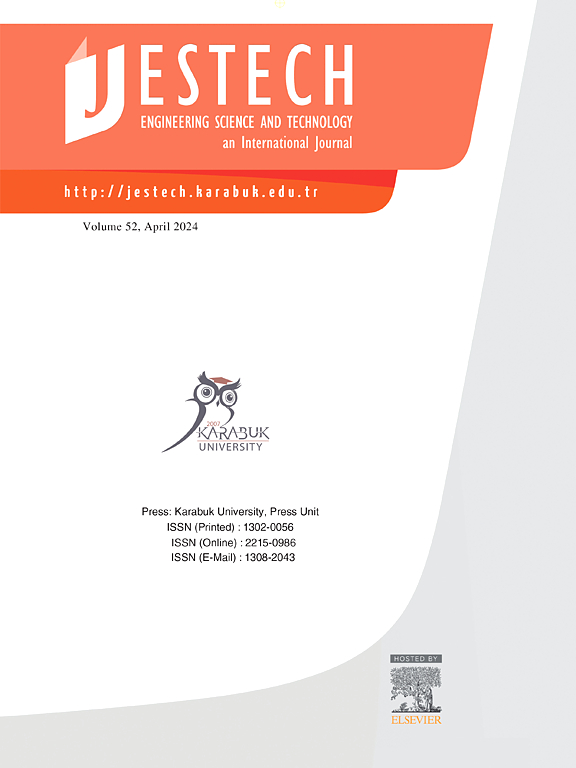径向配电网中电动汽车充电站和分布式发电的优化配置
IF 5.1
2区 工程技术
Q1 ENGINEERING, MULTIDISCIPLINARY
Engineering Science and Technology-An International Journal-Jestech
Pub Date : 2024-11-20
DOI:10.1016/j.jestch.2024.101907
引用次数: 0
摘要
电动汽车的广泛普及需要建立充电站(EVCS),这被认为是对网络的巨大负荷。这就需要优先考虑以减少电网负荷的方式分布充电站,同时重新规划电网并为其提供必要的能源,以保持能源效率和电能质量。总能量损失最小化、电压偏差最小化和电压稳定指数改善是多目标函数中考虑的电能质量指标。车辆到电网(V2G)功能、分布式发电装置(DG)和电容器组可通过注入所需的有功和无功功率来改善系统性能。此外,多目标函数还考虑了 V2G、DG 单元和电容器组的初始成本和运行成本。充电站、V2G、DG 单元和电容器组的最佳大小和分配是通过所提出的自适应多人口精英 JAYA(SAMPE-JAYA)算法来实现的,并使用遗传算法(GA)进行检验。提出的算法通过各种场景和两个标准的 IEEE 测试系统进行了测试。为了强调所提算法的有效性和适用性,还将其应用于现实世界的配电系统。为了适应 EVCS 的优化分配,在 IEEE 33 和 69 总线系统中,EVCS 分别占基本有功负载的 80.7% 和 78.9%。有必要整合占基本负荷 17.35% 和 18.25% 的 DG。此外,在每种情况下,还需要占无功负荷 36.84% 和 31.166% 的电容器组,以实现有效的电压支持和系统可靠性。本文章由计算机程序翻译,如有差异,请以英文原文为准。
Optimal allocation of electric vehicle charging stations and distributed generation in radial distribution networks
The widespread spread of electric vehicles requires the establishment of charging stations (EVCSs), and this is considered a large load on the network. This gives priority to distributing the stations in a way that reduces the load on the network, and in parallel, re-planning the network and supplying it with the necessary energy to maintain energy efficiency and power quality. Total energy loss minimization, voltage deviation minimization, and voltage stability index improvement are the considered power quality indices in the multi-objective function. Vehicle to grid (V2G) feature, distributed generation units (DG), and capacitor banks are used for improving system performance, by injecting the required active and reactive power. In addition, the initial and running costs of V2G, DG units, and capacitor banks are considered in the multi-objective function. The optimal sizing and allocation of charging stations, V2G, DG units, and capacitor banks are performed using a proposed Self-Adaptive Multi-Population Elitist JAYA (SAMPE-JAYA) algorithm and checked using the genetic algorithm (GA). The proposed algorithm is tested using various scenarios, two standard IEEE test systems. To emphasize the effectiveness and applicability of the proposed algorithm, it is applied on a real-world distribution system. To accommodate the optimal allocation of EVCS, which constitute 80.7 % and 78.9 % of the base active load for the IEEE 33 and 69 bus systems, respectively. Integrating DG amounting to 17.35 % and 18.25 % of the base load is necessary. Additionally, capacitor banks, contributing 36.84 % and 31.166 % of the reactive power load, are also required for effective voltage support and system reliability in each respective case.
求助全文
通过发布文献求助,成功后即可免费获取论文全文。
去求助
来源期刊

Engineering Science and Technology-An International Journal-Jestech
Materials Science-Electronic, Optical and Magnetic Materials
CiteScore
11.20
自引率
3.50%
发文量
153
审稿时长
22 days
期刊介绍:
Engineering Science and Technology, an International Journal (JESTECH) (formerly Technology), a peer-reviewed quarterly engineering journal, publishes both theoretical and experimental high quality papers of permanent interest, not previously published in journals, in the field of engineering and applied science which aims to promote the theory and practice of technology and engineering. In addition to peer-reviewed original research papers, the Editorial Board welcomes original research reports, state-of-the-art reviews and communications in the broadly defined field of engineering science and technology.
The scope of JESTECH includes a wide spectrum of subjects including:
-Electrical/Electronics and Computer Engineering (Biomedical Engineering and Instrumentation; Coding, Cryptography, and Information Protection; Communications, Networks, Mobile Computing and Distributed Systems; Compilers and Operating Systems; Computer Architecture, Parallel Processing, and Dependability; Computer Vision and Robotics; Control Theory; Electromagnetic Waves, Microwave Techniques and Antennas; Embedded Systems; Integrated Circuits, VLSI Design, Testing, and CAD; Microelectromechanical Systems; Microelectronics, and Electronic Devices and Circuits; Power, Energy and Energy Conversion Systems; Signal, Image, and Speech Processing)
-Mechanical and Civil Engineering (Automotive Technologies; Biomechanics; Construction Materials; Design and Manufacturing; Dynamics and Control; Energy Generation, Utilization, Conversion, and Storage; Fluid Mechanics and Hydraulics; Heat and Mass Transfer; Micro-Nano Sciences; Renewable and Sustainable Energy Technologies; Robotics and Mechatronics; Solid Mechanics and Structure; Thermal Sciences)
-Metallurgical and Materials Engineering (Advanced Materials Science; Biomaterials; Ceramic and Inorgnanic Materials; Electronic-Magnetic Materials; Energy and Environment; Materials Characterizastion; Metallurgy; Polymers and Nanocomposites)
 求助内容:
求助内容: 应助结果提醒方式:
应助结果提醒方式:


